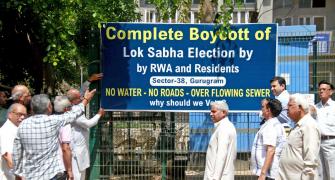With the India Meteorological Department declaring 2007 the fourth warmest year on record since 1901, evidence of global warming on the Indian climate is crystallising.
The annual mean temperature in the country was recorded 0.55 degree Celsius higher than normal (long-period average temperature) in 2007. In all, eight of the 10 warmest years in past 108 years have occurred in the last decade, since 1998.
Significantly, the annual mean temperature in the country has been consistently above normal ever since 1993, except in 1997.
This has been revealed in the "Annual climate summary, 2007" prepared by the IMD. The report, however, steers clear of the controversial issue of climate change and refrains from linking higher local temperatures with global warming or climate change.
However, it categorically states that the year 2007 witnessed extreme weather events across the country, both in terms of temperature and precipitation. During the year, the country experienced severe cold spells, heat waves, floods as well as drought in different parts, which resulted in the death of well over 2,000 people.
The oceans around India also experienced some of the most severe tropical storms and super cyclones.
Notably, all the three years warmer than 2007 have been after 2000. The warmest year in India so far was 2002. It was followed by 2006, 2003 and 2007 in that order.
Of the 10 warmest years since 1901, eight have been after 1998. These were 2002, 2006, 2003, 2007, 1998, 2004, 1999, and 2001, in the order of warmness. The two years earlier than 2000 to figure in the top 10 warmest years were 1941 and 1958.
A severe cold wave prevailed over the northern parts of the country in the first fortnight of January, claiming about 150 lives, the report states.
On the other hand, a heat wave, with maximum temperatures ranging 5 to 7 degrees Celsius above normal, occurred in the northern and central parts of the country during the first 10 days of June. In total, the heat wave conditions during the summer season caused over 400 deaths in different parts of the country.
Besides, over 1,600 people were reported to have been killed in the floods due to heavy rains in the monsoon season in 2007, with about 950 lives being lost in West Bengal alone. Heavy rains in the first fortnight of July claimed over 200 lives in Gujarat.
Moreover, floods in Andhra Pradesh in the last week of June and first week of July and again in the second fortnight of September and the first week of October claimed over 200 lives, the report maintains.
In contrast, moderate drought conditions (rainfall deficiency ranging from 26 per cent to 50 per cent) prevailed in several parts of the north-western and central India.
The affected areas included west Uttar Pradesh, Haryana, Delhi, Chandigarh, Punjab, Himachal Pradesh and east Madhya Pradesh.
Though the total rainfall in the country during the monsoon season (June to September) was 106 per cent of the normal, the post-monsoon rainfall (October to December) was rather poor, just 68 per cent of the normal.
The oceans around India went through some exceptionally stormy conditions during 2007. The first ever 'super cyclone', nick-named GONU, was experienced in June 2007 over the Arabian Sea. It formed over the east central Arabian Sea on June 1, moved in a north-westerly direction and crossed the coast of Oman on June 6.
In the post-monsoon season, a very severe cyclonic storm, named SIDR, was formed over the Bay of Bengal in November. On the whole, four cyclone storms and eight depressions were formed over the Indian seas in 2007, according to the IMD report.








